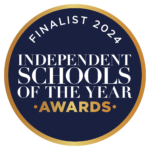Science has been the cornerstone of human progress for centuries, and it is through scientific innovation that many of the most significant advancements in our society have been made. From healthcare to transportation, from communication to energy production, scientific research and development have led to ground-breaking discoveries and technologies that have transformed our world.
At Emanuel School, we take pride in the fundamental science that we teach, and relish in providing windows for students to investigate how the future of science may look. This year’s science week, with the theme of ‘connections’, has been an excellent opportunity for us to do just that.
Science Week Project
During the two weeks preceding half term, Emanuel School held an exciting science week project that gave students in years 7 and 8 the opportunity to explore the world of artificial intelligence, titled ‘machines of the future‘. The project challenged students to design a device that would make everyday life easier, using principles of artificial intelligence and machine learning. The students were encouraged to think creatively and come up with innovative ideas that would improve the quality of their lives.
To prepare for the project, students investigated online AI experiments, such as making art from text, translating objects from photos into different languages, and playing games with machine learning algorithms. These activities gave students a chance to explore the basics of machine learning and its applications in different domains. They learned about the potential of AI to revolutionise different aspects of life, but analysed the potential risks that the technology poses.
The students worked in groups, collaborating, and sharing ideas to create pioneering designs. Some ideas created included a smart water bottle that would remind its owner to stay hydrated throughout the day. The bottle was equipped with sensors that could detect when the owner had not taken a drink in a certain amount of time and would send a reminder to their phone. Another group designed a smart mirror that would analyse the owner’s skin and make personalised skincare recommendations.
The project culminated in an in-class presentation where students showcased their designs. I would like to congratulate the winners of these and hope that they feel inspired to continue learning about how artificial intelligence will shape our world.
Junior Science Club
The weekly junior science club provides students with a fun and exciting way to learn about science outside of the classroom. These clubs provide students with opportunities to experiment, explore, and discover new concepts and ideas. During science week, these ran daily, to provide students with an increased opportunity to do this.
In the first session, students explored the fascinating properties of non-Newtonian fluids, by making slime. They learned that these fluids do not follow the rules of normal physics and are able to change their properties depending on the amount of force applied to them. By making slime, the students were able to see these properties in action and understand how these fluids work. This activity not only provided the students with a better understanding of non-Newtonian fluids but also allowed them to have some fun while doing so.
After this, students delved into the mysteries of DNA, where they extracted their own genetic material from their saliva. The students learned about the basic structure of DNA and how it carries genetic information from one generation to the next. By extracting their own DNA, the students were able to see and touch the building blocks of life.
Then, students investigated the anatomy a fish head via dissection, to observe the different parts, including the eyes, gills, mouth, and brain. The students were amazed by the intricate network of blood vessels and the complexity of the fish’s brain. A discussion followed on the importance of understanding the anatomy of different organisms and how it can help in the study of biology and the ecosystem.
In the last session, the students electroplated brass to create their own jewellery, where they learned about the process and how it can be used to add a layer of metal to an object. Using this information, the students were able to express their creativity to create their own unique pieces of jewellery.
Competitions
One of the highlights of science week were the competitions, which saw students competing for prizes in various challenges. From poster competitions to daily puzzles, students had a chance to demonstrate their knowledge and creativity in different ways.
The theme of the science week was ‘connections in science’, and year 7 and 8 students participated in a poster competition to demonstrate how different scientific concepts and phenomena are connected. The posters were judged, by both students and teachers, on their creativity, clarity, and accuracy, and the winners received fun prizes such as science kits and games.
In addition to the poster competition, the science week also featured daily challenges that kept students engaged and excited throughout the week. The challenges included a sticker challenge, where students had to collect information from stickers that teachers were wearing to deduce the links between departments. In addition, there was a word search centred around famous female scientists, and a crossword and an emoji puzzle that tested their knowledge of scientific terms and concepts.
The most entered competition was the orienteering game. Here, students were tasked with finding posters scattered throughout the school, each containing a piece of the code to unlock a famous quote by a famous scientist. The posters are hidden in different locations, some more challenging than others, and students must use their navigational skills to find them. The code is made up of letters, and as students collect the posters and unlock each code, they piece together the famous quote by the famous scientist.
The game was designed to be fun and engaging, but also to encourage teamwork and problem-solving skills. The famous quote by the famous scientist serves as a reward for their efforts and hopefully the words will inspire them to pursue scientific knowledge and discovery further.
Mr Barker (Deputy Head of Chemistry)













